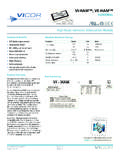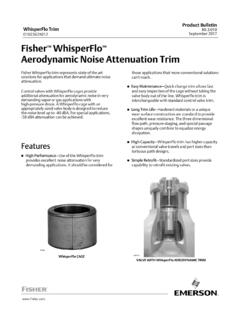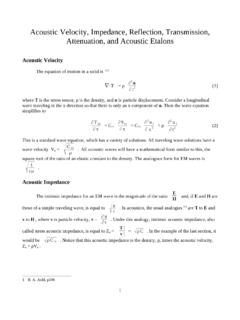Transcription of Radon transform and multiple attenuation - CREWES
1 Radon transform and multiple attenuation CREWES Research Report -Volume 15 (2003) 1 Radon transform and multiple attenuation Zhihong (Nancy) Cao, John C. Bancroft, R. James Brown, and Chunyan (Mary) Xaio ABSTRACT Removing reverberations or multiples from reflection seismograms has been a longstanding problem of exploration geophysics. multiple reflections often destructively interfere with the primary making interpretation difficult. The Radon transform , which integrates some physical property along a particular path, will be evaluated for attenuating multiple .
2 Multiples are periodic in the -p domain, and predictive deconvolution can be applied in the -p domain to suppress multiples. After NMO correction, moveout errors are approximately parabolic and tend to map to points in the parabolic Radon domain. The hyperbolic Radon transform will also map data before and after moveout correction into points, and multiples can be recognized in the Radon domain. The identified multiple energy can then subtracted from the data to improve the interpretation process. INTRODUCTION Johan Radon (1917) is credited with establishing the Radon transform , a function that integrates some physical property of a medium along a particular path.
3 Removing reverberations from reflection seismograms has been a long standing problem of exploration geophysics. multiple reflections often destructively interfere with the primary reflections of interest. The most robust and effective way to suppress multiples is stacking normal moveout (NMO) corrected seismic gathers (Foster and Mosher, 1992). Unfortunately, stacking does not eliminate all multiples. Over the years, many techniques for suppressing multiples have been tried. More recently, the Radon transform approaches have attracted attention.
4 The generalized Radon transform integrates the data along any curved surfaces (Chapman, 1981). Particularly, the slant-stack (or -p ) transform integrates the data along planar surfaces (Treitel, et al, 1982). Hampson (1986) applied NMO-correction to common midpoint (CMP) data and perform a Radon transform along parabolic stacking curve to suppress multiples in NMO-corrected domain. Yilmaz (1989) applied t2-stretching to the CMP data and then applied the parabolic Radon transform in the stretched coordinates. Foster and Mosher (1992) described a hyperbolic Radon transform in stacking NMO-corrected domain.
5 Oppert (2002) proposed the non-hyperbolic Radon transform by taking the shifted hyperbola NMO equations. Thorson and Claerbout (1985), and Beylkin (1987) showed the least-squares solution of the discrete Radon transform . The former also gave the Cao et al. 2 CREWES Research Report -Volume 15 (2003) stochastic inverse solution for the problem. Zhou and Greenhalgh (1994) showed the convolutional operators for the slant-stack transform and the parabolic Radon transform to increase the resolution. Sacchi and Tadeusz (1995) proposed an improved algorithm for the parabolic Radon transform to get higher resolution.
6 The generalized Radon transform (,)uq is defined as ()()(),,uqd xtq x dx ==+ (1) where (,)dxt is the original seismogram, x is a spatial variable such as offset, ()x is the curvature based on which the transform curve is defined, q is the slope of the curvature, and is the intercept time (Foster and Mosher, 1992). Since the seismogram is digitally recorded, a discrete form of equation (1) is: ()()(),,xuqd xtq x ==+ (2) Then the inverse transforms of equation (1) and (2) are: ()()()',,dxtuq tq xdq == , (3) or ()()()',,qdxtuq tq x == (4) Also, we can express the Radon transform in velocity domain (Yilmaz, 1989) as follows.
7 ()()(),,,xuvd xtq vx ==+ (5) ()()()',, ,qdxtuv tq vx == (6) THE DISCRETE Radon transform Equation (3) can be written as: '=dLu (7) where L is the linear transformation from the -q space to the offset space defined by equation (3), and given as follows in Fourier domain: Radon transform and multiple attenuation CREWES Research Report -Volume 15 (2003) 3 ()1 1jkiq xjkj.
8 ,Mek,.., N = = = L (8) Assume that a CMP gather d(x,t) is the result of some transform on a function u0(q, ) in the -q space. In fact, d(x,t) is always contaminated with additive noise n giving: nLud+=0 (9) The solution for u in equation (9) is obtained by taking a least-squares approach to minimize the noise term n, which represents the difference between the actual data u0 and the modelled data u.
9 The cumulative squared noise term, TT00S=n n=(d-Lu ) (d-Lu ) (Oppert and Brown, 2002), is minimized with respect to u0 yielding the desired least-squares solution (Thorson and Claerbout, 1985): []dLLLuTT1 = (10) The generalized inverse of L is thus computed to be 1 TTLL L. The calculation of []1 LLT is impractical due to the large nature of the matrix and the instability of the inversion. Although the operator LLT is diagonally dominant, if the side lobes of the matrix are significant, smearing will occur along the q-axis.
10 Prewhitening the operator LLT suppresses the side lobes and stabilizes the inversion. A stable solution for equation (9) is computed by Thorson and Claerbout (1985): []dLILLuTT1 += (11) where the constant is a damping factor incorporated to add white noise along the main diagonal of the inversion matrix, and I is the identity matrix. Cao et al. 4 CREWES Research Report -Volume 15 (2003) THE LINEAR Radon transform Theory () () +==dxpxtxdpu ,,, (12) ()() +==xpxtxdpu ,,, (13) () () ==dppxtputxd ,,', (14) ()() ==ppxtputxd ,,' (15) The equation (1) reduces to the linear Radon transform when ()







